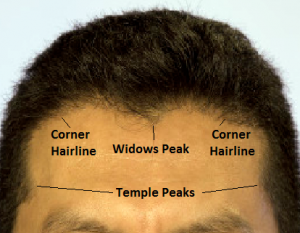What constitutes a good way to follow genetic balding? So far it seems to be a vague art that varies between doctors, and not something that will give an intelligent person an understanding of what is happening to them.
Miniaturization occurs in men and women who are balding. Miniaturization is the process where a normal thickness hair shaft becomes thinner and thinner over time due to the genetically determined effects of aging and/or androgenic hormones on the terminal (normal) hair follicle. The process of miniaturization is a slow process in genetic balding. Hair shafts may lose 10% of their diameter, then 20%, then 30% and so on. Each degree of increased miniaturization reflects further progression of the genetic balding process. The instruments that measure miniaturization were invented (and patented) by me in the early 1990s and they are in wide spread use today. Socially detectable hair loss is not evident until more than 60% of the hair has been lost and as a result, many men do not seek out expert help until they see some evidence of balding (which they too often deny).
When a doctor views the scalp hair with high magnification, the degree of miniaturization and the location of the miniaturization are both critical to establishing (1) the diagnosis and (2) the rate of the process, which progresses over time. Because miniaturization is a relative measurement at any one time (comparing finer hair to the thickest hair), it takes substantial experience before this measurement can be useful to the individual clinician. In our experience, from examining and following thousands of patients with the Hair Densitometer, we have found that assessing the degree of miniaturization has useful predictive value when evaluating the risks of hair loss and in establishing hair loss patterns. The amount of miniaturization in each section of the scalp tells the physician just how far the balding is progressing or has progressed. In men who show more and more areas of miniaturization over time, the genetic balding can be considered active.
A high degree of miniaturization in the upper portion of the fringe area in a Norwood Class 6 pattern (see below in red) suggests that the donor fringe will lower over time so a person who may be a Class 6 pattern balding pattern may become a Class 7 pattern, reducing the fring around the sides and back to a 3 1/3 inch band. A high degree of miniaturization throughout the donor area indicates that all of the patient’s hair may be unstable for hair transplantation and that he may be at risk to have diffuse unpatterned alopecia with extensive balding, even on the sides and in the back of the head (an area normally not affected by any balding or miniaturization in most men). The unpatterned alopecia is characteristic of women’s genetic balding pattern which is often found all over the head including the back and sides.
Miniaturization in the recipient area (front, top and crown) can often delineate which areas of the scalp are most likely to bald and which are stable, anticipating the patient’s future Norwood hair loss classification. If a man has 90% miniaturization in the crown (back of the head) and only 30% in the mid scalp, the physician may assume that the crown is at a higher risk of earlier hair loss than the mid-scalp, giving him an eventual Class 4 or 5 balding pattern.
We feel that in predicting the short-term loss, the extent of miniaturization in the recipient area, as well as the rapidity of the loss, is critical in establishing the guidelines for treatment, whether it is a hair transplant or drug intervention. In the very early stages of hair loss (the many in his early-mid twenties), increased miniaturization can anticipate future balding even before any loss can be seen to the naked eye. Often the reason a person seeks a consultation for hair restoration expert is that there is some change in the “rate” of his hair loss (often more hair seen on the pillow or in the shower). A patient who is very gradually losing his hair is less likely to seek help than a patient who suddenly has acceleration in the rate that he is losing hair. Usually large numbers of hairs undergo miniaturization before any are actually lost and the time the drugs are most effective is in this early phase. In men, DHT is the hormone responsible for these changes.
For the most reliable prediction of the final hair loss pattern, the patient should be over the age of 25 (above 30 is better) and have some visual evidence that the process has started. A base measurement and subsequent follow up measurements are essential to the proper management of hair loss by any doctor considered to be an expert in the field. By understanding these measurements over time, the doctor will understand just what this all means and better yet, the patient now has a way to follow what is happening to him/her. Many young men worry about following their father’s or mother’s male family balding history and come to the office to find out what their future has in store for them. The microscopic assessment for miniaturization is the best way to determine this.
With successful medical (drug) treatments like Propecia in men, the miniaturization may be reversed (partly or completely). The responsiveness of each patient is different, so each patient must be diligent in follow up measurements of the degree of miniaturization and the location of the miniaturization by scalp location. The same diagnostic criteria should and must be followed in women. Without good measurements for miniaturization, there is no clinical science in the treatment of hair loss, just hocus-pocus and blustering, a problem that is far too frequent today.

